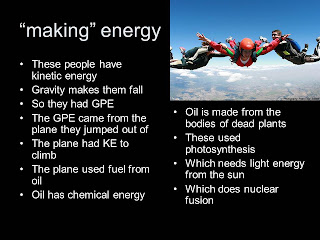The table below shows some household appliances with
their power ratings and how long they are used for in a typical day. Complete
the table by working out how many units of electricity are used in each
situation and the cost if one Unit (1 kilowatt-hour) is 12p.
|
|
|
|
|
|
|
|
|
Tumble dryer
|
3.5
|
X
|
1
|
=
|
3.5
|
X 12
|
4.2
|
Electric fire
|
2
|
X
|
3
|
=
|
6
|
X 12
|
7.2
|
Electric shower
|
10
|
X
|
0.2
|
=
|
2
|
X 12
|
24
|
Hall light
|
0.1
|
X
|
5
|
=
|
0.5
|
X 12
|
6
|
Radio
|
0.05
|
X
|
4
|
=
|
0.2
|
X 12
|
2.4
|
Electric kettle
|
3
|
X
|
0.4
|
=
|
1.2
|
X 12
|
14.4
|
Television
|
0.16
|
X
|
5
|
=
|
0.8
|
X 12
|
9.6
|
Fridge-freezer
|
0.1
|
X
|
24
|
=
|
2.4
|
X 12
|
28.8
|
Oven
|
3
|
X
|
0.45
|
=
|
1.35
|
X 12
|
16.2
|
1
A laptop computer has an electricity supply
of 20 V and takes a current of 4 A. What is its power?
P = I x V = 4 A x 20 V = 80 W
2
A light bulb uses the mains supply of 230 V. The current through the bulb is 0.1 A. What is the power of the light bulb?
P = I x V = 0.1 A x 230 V = 23 W
3
The light bulb in question 2 is switched on for 10 minutes. How
much energy does it use? (Hint: use
energy = power × time and remember to convert the time into seconds.)
E = P x t = 23 W x (10 x 60 s) = 13 800 J
4
A 3 kW
electric fire is switched on for 2 hours. Electricity costs 12p per kW h. How much does it cost to use the fire?
kWh used = kWh x h = 3 kW x 2 hrs = 6 kWh Cost = 6kWh x 12p = 72p
5 A 2 kW
electric heater is used for an hour.
a What
is the power of the heater in watts? 2000 W
b How
many seconds are there in 2 hours? 2hr x 60 min x 60 s = 72 000 s
c How much energy (in Joules) does the heater use while it is switched on?
E = P x t = 2000 W x 72 000 s = 144 000 000 J = 144 MJ
d How
much energy does it use in kilowatt-hours? E = 2kW x 2 hr = 4kWh







































